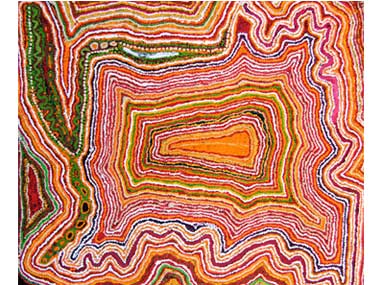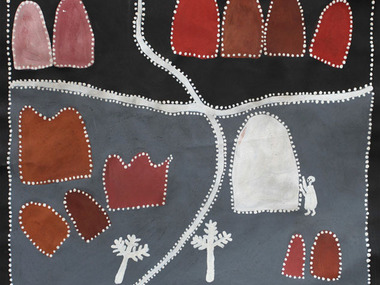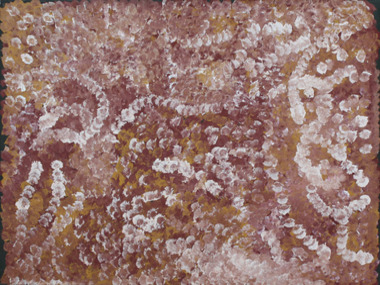'TOURIST TAT' IN HOBART

The wonderful Jimmy Donegan's 'Wati Kutjara', 2013, acrylic on canvas 122x122
Posted by Jeremy Eccles | 13.01.14
Gallery: Art Mob - Aboriginal Fine Art
Dates:
10.01.00
: 26.01.00
Back in September, I responded to some depressingly bad critical reviews of the Indigenous content in the big Australia show at the Royal Academy in London. My blunt heading then was 'Crap Criticism in London'. Coincidentally, the Hobart art gallery director, Euan Hills of Art Mob decided he needed to respond too, with a show that he decided to call, Tourist Tat & other problematic, tokenistic spotty meanderings, availing himself of some of the more extreme comments by so-called critics.
Such a synergy of thought lead Hills to invite me to launch his show last Friday. And here's what I said:
"Of course, our friend and guide Euan has his tongue firmly in his teeth in the title chosen for this show – picking at random some of the silliest phrases from the London 'critics' (inverted commas) of the Royal Academy's big 'Australia' show in September last year – and then throwing their folly back in their teeth by showing some of the finest Indigenous art on offer today – including a ripper 'dump-dump' Emily, a heartfelt Christian Queenie and an intensely ceremonial Jean-Baptiste – such late great ladies.
But it is a serious problem that more than 40 years after Kaapa Mbitjina first picked up a brush in Papunya that the Australian art world has failed to promote a greater understanding of what Robert Hughes would come to recognise as “The last great art movement of the 20th Century” around the visual arts world. Or indeed the world's visual arts markets. As I pointed out in the story I wrote for the Aboriginal Art Directory website called “Crap Criticism in London”, the man who wrote some of the silliest things in the once great Sunday Times newspaper – the unpronounceable Waldemar Januszczak – has actually been voted Critic of the Year twice in the UK!
And as someone who once a proud member of the International Association of Theatre Critics, writing at length about theatre criticism in Australia, I would never have dared to enter a performance as ignorant of my artform and its possibilities, with the intention of criticising it, as he did.
I should make it clear – unlike some other local commentators on 'Australia's' reception in the UK – there really were only 2 or 3 idiots given media space to vent their ignorance. The FT and the Independent critics both showed that they had an understanding of their professional responsibilities in their writing, and had possibly read sculptor Anthony Gormley's insightful comments on the nature of Aboriginal art supplied by the Royal Academy... “While artists from a deracinated European tradition continue to make pictures, the native Australian maps the experience of being the land and allows it to move through him or her. There is a directness in the Indigenous traditions - whether the dots of the Western Desert or the colour field paintings of the Great Sandy Desert - where pigment is used to carry mineral truth as well as lived feeling”.
They might also have read up in the catalogue the combined thoughts of Wally Caruana and Franchesa Cubillo (past and possibly present Chief Curators of Aboriginal art at the National Gallery) which challengingly begins by calling Aboriginal art “a revolution in Australian painting” (which many white artists still don't see); and goes on to explain that land is a “spiritual entity” for those artists “not just mundane landscape”. Then, putting it in terms that connoisseurs of European art ought to have understood, they emphasise that the development of Papunya dotting and more apparently 'abstract' patterning in Desert painting was never a response to the demands of a white marketplace but was an aesthetic response to the realised need to protect the uninitiated from the power of their sacred imagery.
Whatever they might have done to prepare themselves for “the experience of being the land”, they were certainly not faced by “the complete absence of critical matrix to assess the work” as my normally thoughtful friend Nicolas Rothwell opined in The Australian. Rothwell then goes on to quote The Independent critic's sociological backgrounder suggesting that a horrendous past to black and white relations in Australia might well justify us in unnaturally “ennobling their culture” and therefore buying their art for political or social reasons rather than aesthetic pleasure. But he then quite fails to add that critic's heroic conclusion: “The meaning of the circles, lines and dots may be obscure to the Western viewer, but not the overall effect of swirling shapes and ochre backgrounds in works by John Mawurndjul, Emily Kngwarreye and the group effort of the Martumuli Community. No wonder Australia puts so much emphasis on its native Aboriginal artists. They at least seem confident in their dreaming“.
Rothwell attempts to suggest that “patinated mid-Century barks” clashed with “more-polished contemporary desert acrylics” such as to confuse the dumber critics. Studying the catalogue, I was much more taken by the possibility of an astute critic spotting the relationship and artistic development that had taken place between Mawalan Marika's 1965 'Milky Way' bark and Gulumbu Yunupingu's abstracted 'Garak/The Universe' bark 40 years later. Or recognising John Mawurndjul's artistic leap from a 1991 Rainbow Serpent to his 2006 all-rarrked tracery today.
But let us briefly wallow in the un-astute, the unprepared, the blinkered – starting with Brian Sewell in The Daily Mail: “These examples of contemporary aboriginal work are so obviously the stale rejiggings of a half-remembered heritage wrecked by the European alcohol, religion and servitude that have rendered purposeless all relics of their ancient and mysterious past. Swamped by Western influences, corrupted by a commercial art market as exploitative as any in Europe and America, all energy, purpose and authenticity lost, the modern Aboriginal Australian is not to be blamed for taking advantage of the white man now with imitative decoration and the souvenir. The black exploits the white’s obsession with conspicuous display and plays on the corporate guilt that he has now been taught to feel for the ethnic cleansing of the 19th century — a small revenge for the devastation of his culture — but the Aborigine offers only a reinvented past, his adoption of “whitefella” materials and, occasionally, “whitefella” ideas (Jackson Pollock must surely lie behind the longest of these canvases – the 8 metre 'Big Yam' by Emily Kngwarreye) undoing his (or possibly her) “blackfella” integrity”.
Midst all of Sewell's 'cool' usage of black and whitefella terms, he did at least retain an iota of credibility for not suggesting that the only Indigenous art he recognised was to be found on cave walls – as the precious Waldemar did. He announced that the Indigenous element of the survey was “tokenistic”, preferring 'original' ancient rock art to the “dull canvas approximations, knocked out in reduced dimensions by a host of repetitive Aborigine artists making a buck. Out of a tremendous Indigenous tradition, fired and inspired by an enormous natural landscape, the Australian art world has managed to create what amounts to a market in decorative rugs. Opening the show with a selection of these spotty meanderings, and discussing them in dramatically hallowed terms, cannot disguise the fact that the great art of the Aborigines has been turned into tourist tat".
I guess Andy Warhol and Damien Hirst never thought of “making a buck”! Or Albert Namatjira – whom Waldemar liked rather a lot! The dear old-fashioned, patronising thing!
I have to admit that at least Waldemar was writing about the show. Melbourne academic Peter Conrad, writing in The Monthly seems to have seen the show, but reviewed the catalogue! From his ivory tower, he gets stuck into the Caruana/Cubillo chapter for “brandishing” Bob Randall's slogan, “The Land Owns Us” - though a reading of the footnotes credits Galarrwuy Yunupingu with the statement. “The land does not own us”, the colonial Conrad brandishes in return, “even if we are buried in it. The myth of the songlines is as proprietorial as the fussing of colonists about borders and fences, and equally deluded”.
Oh dear. It seems that we may have to start at home with an education program about traditional Indigenous views of Country, property (and propriety). I wonder whether Mr Conrad has been talking to his fellow-academic Gary Foley who long ago gave up on land rights in favour of land ownership? Or perhaps he's been reading and believing proppaNOW provocateur, Richard Bell's insulting 'Bell's Theorem' with its assertion that the 'Ooga Boogas' of remote Australia are only making work for tourists, while 'The Dreaming' has passed to him in Brisbane! Or could he even have heard Vernon Ah Kee complaining that he wasn't seen as “primitive enough”, burdened as he was by the popularity of the “art of Stone-Age Aborigines”.
But before we rush out to educate, let us bring our finer critical minds to bear on great Australian art as offered all around us by Euan Hills – which, apart from the delights of Minnie Pwerle's “decorative rug”, is a match for much that was in London at the Royal Academy, and indubitably superior in offering the Jimmy Donegan, an APY masterpiece – and APY art is so often left out of 'official' shows like 'Australia' for no reason I've ever discovered.
You really are very lucky to have Euan in Hobart – offering such a range and such a quality of Indigenous art here, as good or better than any single gallery in Sydney.
Share this:
»  del.icio.us
»
del.icio.us
»  Digg it
»
Digg it
»  reddit
»
reddit
»  Google
»
Google
»  StumbleUpon
»
StumbleUpon
»  Technorati
»
Technorati
»  Facebook
Facebook
Contact Details
Gallery: Art Mob - Aboriginal Fine Art
Contact: Euan Hills
Email: euan@artmob.com.au
Telephone: +61 3 6236 9200
Address: 29 Hunter Street Hobart 7000 TAS
Gallery: Art Mob - Aboriginal Fine Art
Contact: Euan Hills
Email: euan@artmob.com.au
Telephone: +61 3 6236 9200
Address: 29 Hunter Street Hobart 7000 TAS

A 1995 work by the late Queenie McKenzie - 'Texas Hills with Termite Mound'

A 1993 'dump-dump' Emily Kngwarreye, 'Bush Potato', acrylic on canvas 150x 202 cms
Where is the exhibition?
Further Research
Gallery: Art Mob - Aboriginal Fine Art
Artists: Albert Namatjira | Emily Kngwarreye | Gulumbu Yunupingu | Jean-Baptiste Apuatimi | Jimmy Donegan | John Mawurndjul | Kaapa Mbitjina | Mawalan Marika | Queenie McKenzie
News Tags: Art Mob | Australia | Brian Sewell | Euan Hills | Jeremy Eccles | National Gallery of Australia | Nicolas Rothwell | Peter Conrad | Royal Academy | Waldemar Januszczak
News Categories: Australia | Blog | Exhibition | Feature | Industry | News
Exhibition Archive
- 10.10.17 | TARNANTHI 2017
- 11.08.17 | Natsiaas 2017
- 20.07.17 | APY ART DOMINATES THE WYNNE
- 17.07.17 | Anangu Artist Wins $100,000 Prize
- 14.07.17 | The End of AAMU
- 11.07.17 | ART ACROSS THE COUNTRY
- 11.07.17 | TARNANTHI IN OCTOBER
- 05.07.17 | TJUNGUṈUTJA - from having come together
- 13.06.17 | Ghost-Nets Straddle the World
- 07.06.17 | Grayson Perry Going Indigenous?
- 05.06.17 | Barks Bigger than Ben Hur
- 27.05.17 | NGA QUINQUENNIAL 2017
- 21.05.17 | Blak Douglas Finds Home at the NGA
- 21.05.17 | BRIAN ROBINSON WINS HAZELHURST WOP
- 18.05.17 | PARRTJIMA 2.0
Advertising

